Mark Sisson's Blog, page 98
August 13, 2019
Dear Mark: Vitamin K2 and Microworkouts
 For today’s edition of Dear Mark, I’m answering questions about vitamin K2 and microworkouts. The last two posts on both topics garnered a number of good questions. What’s the best dose of vitamin K2? Should statin users taking vitamin K2, since statins inhibit vitamin K2 activity and production? Can vitamin K2 prevent or reverse arterial calcification? Is butter an adequate source of vitamin K2? What about vitamin D—does it synergize with vitamin K2? Regarding microworkouts, what if you can only do a couple pull-ups at once? Should you alternate muscle groups when doing microworkouts? Can microworkouts work with normal gym workouts? How does one do microworkouts in an office?
For today’s edition of Dear Mark, I’m answering questions about vitamin K2 and microworkouts. The last two posts on both topics garnered a number of good questions. What’s the best dose of vitamin K2? Should statin users taking vitamin K2, since statins inhibit vitamin K2 activity and production? Can vitamin K2 prevent or reverse arterial calcification? Is butter an adequate source of vitamin K2? What about vitamin D—does it synergize with vitamin K2? Regarding microworkouts, what if you can only do a couple pull-ups at once? Should you alternate muscle groups when doing microworkouts? Can microworkouts work with normal gym workouts? How does one do microworkouts in an office?
Let’s find out:
What’s the recommended dose of vitamin K2?
There’s no official RDA for vitamin K2. For vitamin K in general, it’s 0.09 mg. As some of the commenters have alluded, very few medical professionals have vitamin K2 on their radar. I wonder if the RDA is sufficient.
Up to 45 mg per day of MK4 has been shown to be safe and well-tolerated in women, though I don’t think that much is necessary. Some use close to that much when dealing with osteoporosis, arterial calcification, or dental issues, although the reports are all anecdotal.
Many take 1 mg of vitamin K2 as “maintenance.” I’d be comfortable taking that (and sometimes do).
I put 0.08 mg of K2 (MK7) in my Master Formula supplement. Women who are pregnant and those who take anticoagulant medications should talk to their doctor before taking more than the RDA.
So, would taking K2 make statins safer? Do you think you could take enough K2 to prevent clogged arteries or reverse clogged arteries?
I imagine they would, much like taking CoQ10 (another compound whose synthesis statins inhibit) during statin therapy can reduce statin side effects and lower inflammation. Can’t hurt to try.
As for clogged arteries, it can definitely reduce the risk of arterial calcification (by putting calcium where it belongs and not where it doesn’t). Reversal? There aren’t any studies in humans, but vitamin K2 MK4 has been shown to reverse clogged arteries in rats.
Do you have a source on muscle meat (of any type) having Vitamin K?
From this study.
I had read of recommendations of cod liver oil along w K2 which was obtained with grass fed butter. Would grass fed butter be a good source in your opinion
It’s possible, but the sources I’ve read show that majority of butter is very low in vitamin K2. Still, Weston Price swore by concentrated butter oil from grass-fed cows as a source of vitamin K2. You can still buy butter oil if you want to go that route (though you won’t get any solid data on vitamin K2 content).
I wouldn’t rely on straight butter for your vitamin K2.
Isn’t it important to take K2 when supplementing with oral D3? I’ve been seeing liquid D3 preparations with K2/MK7 added.
Yes. Vitamin D3 helps us absorb dietary calcium, and vitamin K2 helps us utilize the calcium in the right way.
What if you can only do 2-3 pull-ups to begin with? ?
That’s the perfect place to start.
Do a single pullup every time you pass the pullup bar (or branch, ledge, gym rings, etc). That’s it. One clean pullup. Don’t struggle. Don’t strain. It should feel easy. Do that single pullup every time you pass the bar. Then, when you feel ready, try doing two each time. And then three.
Suddenly, your max pullups will have doubled.
Should you alternate microworkouts by muscle group each day as with traditional strength training or can you do microworkouts covering all muscle groups each day?
You could, but I find that microworkouts give enough rest that you can work the same muscle on consecutive days. It really depends on the intensity though. If your idea of a microworkout is a 20 rep set of breathing squats with your own bodyweight on the bar, and you do that a few times a day, I would not advise doing it every day.
I don’t claim that microworkouts in this manner will optimize your muscle hypertrophy. I do claim that they’ll keep your days active, keep you healthy, keep you mobile, and get you strong.
I love the idea that any exercise is better than none at all. But I wonder if this style of workout would interfere with recovery from other more regular/scheduled workouts (weightlifting, etc…)?
On the contrary, I find that microworkouts prepare me for the more concerted, formal efforts in the gym.
My buddy Angelo Delacruz is an example of a guy who’s “always on” because he’s always doing little movements throughout the day: dancing to the music playing at the gym, busting out a quick little stretch routine, doing some clapping pushups, breakdancing. He’ll just launch into a set of heavy snatches or clean and jerks without warming up because his joints are all lubed up from the frequent microworkouts.
Well I stand at my computer most of the day 6a-2p with several sets of stairs during that time–I duck into an empty meeting room to run off 15-20 pushups a few times a day, and at lunch a few days a week ( i usually IF til 3-4p ) I do some heavy weights at the local gym for about 20 minutes or so–then comes the yard work on occasion and would you count shopping with the wife at a Big Box store as a micro workout? So How an I doing? I know Mark, Just keep moving!
You’re doing great. I see nothing to add.
As for shopping, sure, why not? Shopping can work.
I’ve been known to curl the groceries as I walk out to the car. Overhead press the cases of mineral water. Plant my feet and do cable crosses with a heavy shopping cart. Sure used to embarrass my kids.
It gets more difficult when on-site for a client. Most offices here aren’t air conditioned, so when it’s warm you’re really going to sweat which makes you less presentable. I try to make it up by picking a hotel in walking distance (~45-60min ish). If there isn’t a private space to knock out a couple of body weight exercises there isn’t a lot you can do without becoming the resident office weirdo. Maybe someone has an idea?
I wrote a post years ago about training in the office without becoming the resident weirdo. See if any of these suggestions work for you. Things are probably different when you’re in someone else’s office.
Walking meetings come to mind. Stair stuff—sprints, jumps, or simply just walking all the flights in one fell swoop. Doing as many squats as possible in the elevator before someone else enters and looks at you funny. Pushups in the bathroom stall.
Okay, maybe not that last one.
The AC thing would make it difficult, though. I can see that.
This is it for today, folks. Take care, be well, and ask any other questions you have down below!

The post Dear Mark: Vitamin K2 and Microworkouts appeared first on Mark's Daily Apple.



August 12, 2019
Primal + Keto Cooking Made Easy: Easy Peasy Pesto
 Pesto is one of the most versatile sauces in terms of use—and preparation. An herb, a nut, some garlic and good quality oil are really all it takes to put together a tasty pesto sauce you can use on virtually any meat or veggie dish. (We love it as a topping or marinade for chicken!)
Pesto is one of the most versatile sauces in terms of use—and preparation. An herb, a nut, some garlic and good quality oil are really all it takes to put together a tasty pesto sauce you can use on virtually any meat or veggie dish. (We love it as a topping or marinade for chicken!)
This easy, simple pesto recipe offers a perfect go-go recipe when you want that classic basil and pine nut pesto flavor. What will you use it for?
Easy Peasy Primal Pesto
Servings: 4
Time In the Kitchen: 5 minutes
Ingredients:
2 cups fresh basil leaves
2 cloves garlic
1/3 cup pine nuts
1/2 cup fresh Parmesan cheese
1/4 teaspoon salt
1/4 teaspoon black pepper
1/2 cup Primal Kitchen® Extra Virgin Avocado Oil (or olive oil if preferred)
Instructions:
Put torn basil leaves, garlic cloves and pine nuts in a food processor or blender. Pulse for about 10 seconds or until garlic appears well chopped. Add cheese and salt and pepper. Run processor while you pour in oil and blend well into a spoonable sauce. (If you’ll be storing rather than using right away, add a squeeze of fresh lemon juice to maintain color.) Enjoy!

Nutritional Information (per serving):
Calories: 392
Total Carbs: 4 grams
Net Carbs: 3.5 grams
Fat: 39 grams
Protein: 5.5 grams

The post Primal + Keto Cooking Made Easy: Easy Peasy Pesto appeared first on Mark's Daily Apple.



August 11, 2019
Chicken Hemp Meatballs with Romesco Sauce
 Pasta and meatballs are a classic, comforting dish, but there’s more possibilities than the carb-heavy grain pasta and beef meatball version. You’ll find these chicken hemp meatballs to be a little lighter and more nuanced. Over a helping of spiralized zucchini, it’s the perfect match of freshness and taste, but let’s not stop there. With a rich but bright Romesco sauce, this dish opens up a whole new world of Italian flavor.
Pasta and meatballs are a classic, comforting dish, but there’s more possibilities than the carb-heavy grain pasta and beef meatball version. You’ll find these chicken hemp meatballs to be a little lighter and more nuanced. Over a helping of spiralized zucchini, it’s the perfect match of freshness and taste, but let’s not stop there. With a rich but bright Romesco sauce, this dish opens up a whole new world of Italian flavor.
Tips: Enjoy these meatballs over your favorite primal noodle. You can use raw zucchini noodles or lightly saute or roast them prior to eating. You can also serve these meatballs over cauliflower rice, spaghetti squash or sweet potato noodles. If you don’t have hazelnuts, you can switch up the romesco sauce by substituting almonds or walnuts. For more flavor, roast the nuts prior to blending them into the sauce.
Servings: 3
Prep Time: 25 minutes
Cooking Time: 60 minutes
Ingredients:
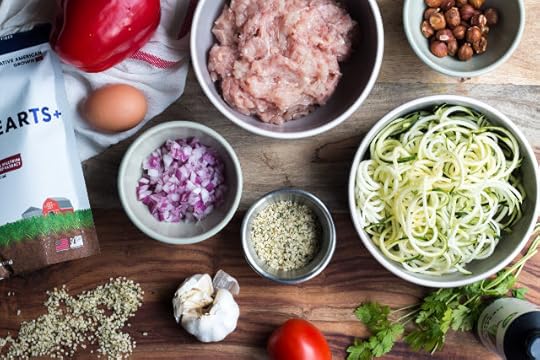
Meatballs:
12 oz. ground chicken thighs
2 Tbsp. EVO Hemp Hearts
2 Tbsp. minced red onion
2 Tbsp. chopped parsley
2 Tbsp. almond flour
½ Tbsp. olive oil or avocado oil
2 cloves garlic, minced
¼ tsp. ground black pepper
¼-1/2 tsp. salt
1 large egg
Romesco Sauce
1 red bell pepper (about 1 cup) + drizzle of Primal Kitchen Avocado Oil
½ roma tomato (about ¼ cup)
3 Tbsp. hazelnuts
2.5 Tbsp. chopped parsley
1.5 Tbsp. olive oil
1/2 Tbsp. red wine vinegar
½ Tbsp. EVO Hempseed Oil
1 clove garlic, minced
For serving:
2 cups spiralized zucchini
Chopped parsley and hemp seeds, to garnish
Instructions:

Preheat your oven to 375 ºF. Rub avocado oil all over the pepper and tomato and place it in the oven on a parchment covered sheet pan or oven-safe dish. The tomato will only need 15-20 minutes to be nicely roasted. Remove the tomato and set it aside once roasted and soft. Flip the pepper every 15 minutes or so until the skin of the pepper is nicely charred. This will take about 50-60 minutes in all. Set the pepper aside with the tomato to cool.
In a bowl, combine all of the meatball ingredients together. Allow the mixture to rest for 5 minutes. Form 9-12 meatballs from the mixture and place them on a lightly oiled sheet pan or glass dish. Bake for about 20 minutes or until they reach an internal temperature of 165 ºF.
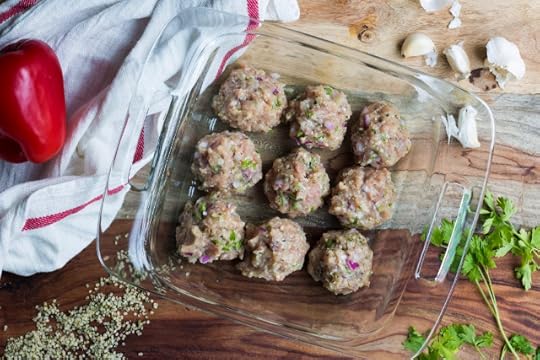
Peel the stem of the pepper off and discard the stem and the seeds inside of the pepper. Run the pepper under water and peel off and discard the skin of the pepper. Place the pepper, tomato, and remaining romesco ingredients in a blender or food processor and blitz until the nuts are small and a sauce forms. You can leave the sauce a little rustic and chunky or blend it more to make it smooth.
Spoon some of the romesco sauce over your zucchini and top with the chicken meatballs. Spoon the remaining sauce on top and garnish with chopped parsley and hemp hearts. Enjoy!
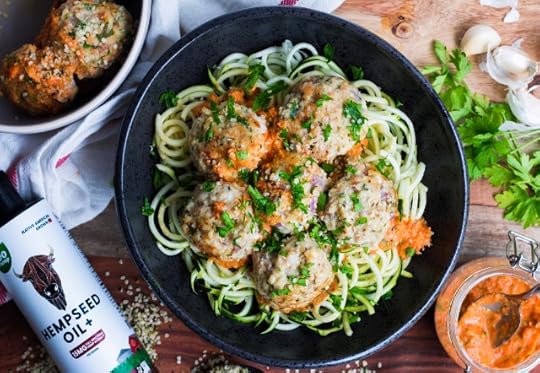
Nutritional Information (3 servings, per serving):
Calories: 435
Total Carbs: 14 grams
Net Carbs: 10 grams
Fat: 28 grams
Protein: 33 grams

The post Chicken Hemp Meatballs with Romesco Sauce appeared first on Mark's Daily Apple.



August 9, 2019
Weekly Link Love — Edition 41

Research of the Week
Even without weight loss, a high-protein, low-carb diet improves glucose tolerance and lowers liver fat in type 2 diabetics.
As fasting glucose ticks upward, so does pancreatic cancer incidence.
Just 12.2% of American adults have optimal (biologically appropriate) metabolic health.
Stress interferes with the mother-child bond.
New Primal Blueprint Podcasts

Episode 362: Andre Obradovic: Host Brad Kearns chats with Andre Obradovic about the importance of not being a muppet.

Episode 363: Luis Villasenor and Tyler Cartwright: Host Elle Russ chats with KETOGAINS founders Luis and Tyler.

Primal Health Coach Radio, Episode 21: Hosts Erin and Laura chat with Todd McCullough about using pain to reflect and progress.
Each week, select Mark’s Daily Apple blog posts are prepared as Primal Blueprint Podcasts. Need to catch up on reading, but don’t have the time? Prefer to listen to articles while on the go? Check out the new blog post podcasts below, and subscribe to the Primal Blueprint Podcast here so you never miss an episode.
Media, Schmedia
More pharmaceutical data shenanigans.
Interesting Blog Posts
The core is the healthiest part of the apple. Just make sure it’s organic.
Ten findings that contradict (and appear to disprove) medical wisdom.
Social Notes
Interesting thread on making sourdough with ancient Egyptian yeast.
Everything Else
Is society scapegoating meat, particularly red meat?
Sure, let’s just slap on a robotic tail for “balance.” What harm could it do?
Another reason to pay attention to your surroundings when hiking.
Incentivizing organ donation by giving registered donors priority if they need a new organ increases organ pool but lowers organ quality.
Things I’m Up to and Interested In
News I’m pleased to announce: Primal Kitchen® took first place in several categories of Paleo Magazine’s annual “Best of” awards, including Best New Product (our ketchup and mustard), Best Paleo Food Company, and Best Paleo Lifestyle Company. Thanks, everybody!
Podcast I enjoyed: The story of the man who survived incurable brain cancer.
Phrase I found clever: “Benevolent pseudo-diabetes.”
I’m impressed: 89-year-old Joe Stockinger deadlifts 405 pounds. Twice.
I have to add the “correlation is not necessarily causation” caveat: Countries with more butter have happier people.
Question I’m Asking
How many unintended physiological consequences would a robotic tail trigger in the human body?
Recipe Corner
Chorizo “rice” bowls. Or you could use real rice, if you go for that sort of thing.
Joe’s Special Frittata is actually pretty simple but still very special.
Time Capsule
One year ago (Aug 4– Aug 10)
Mark’s Resistance Band Workout at Home– My real basic, real quick way to workout in a pinch.
Alcohol While Keto?– Good idea?
Comment of the Week
“The parking lot at Target is on a slight hill so I park at the bottom, and then I can ride the shopping cart like a scooter all the way back down to my car. I’m going to be 61 soon.
Joy and delight!”
– That’s the spirit, Jen!

The post Weekly Link Love — Edition 41 appeared first on Mark's Daily Apple.



August 8, 2019
Menopause: Beyond the Stereotypes
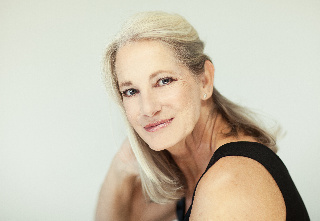 Disclaimer: I have not gone through menopause. I am, however, turning 40 this year. Statistically speaking, this is the decade in which I’m likely to enter perimenopause, so I have a vested interest in understanding what might be in store for me.
Disclaimer: I have not gone through menopause. I am, however, turning 40 this year. Statistically speaking, this is the decade in which I’m likely to enter perimenopause, so I have a vested interest in understanding what might be in store for me.
I’m all too familiar with the stereotype of the belligerent, out-of-control menopausal lady plagued by hot flashes and mood swings, bewildering her poor, beleaguered partner. [Note that for convenience I am going to use “menopause” to include the perimenopausal period as well.] Frankly, this narrative doesn’t suit me at all. I know very well that hot flashes and mood swings can be a part of menopause, but obviously there’s a lot more to it than that.
Of course, I want realistic view of what lies ahead so I might prepare mentally, emotionally, and physically. However, I also want the nuances. Plus, as an optimist I want to know the good, not just the bad and the ugly. To my mind, any major life transition is a chance at a reawakening of sorts, even if the road through it is rocky. My natural tendency is to find the silver lining and reframe situations as growth opportunities.
Menopause is much more than a collection of symptoms that need to be combatted. However, much of what’s written about menopause, from the scientific literature to the blogosphere, focuses on coping with and dealing with menopause. After a while, one wonders if the scientific and medical communities aren’t overeager to problematize and medicalize menopause by putting all the focus on the symptoms and, naturally, the treatments (they can make money off of). You have to dig deeper to find discussions about the meaning of menopause through the eyes of women who are living it.
Nevertheless, plenty of women and scientists (and women who are scientists!) are exploring how menopause fits into the flow of a woman’s life. I came away from my research seeing that menopause is, in fact, not terrible for many women. There’s tremendous variation in individual women’s experiences of menopause, not only in terms of the actual symptoms but also in the way she appraises them. Menopause is far more nuanced and idiosyncratic than sitcom stereotypes or medicalized portrayals would have us believe. It can be a time of tremendous growth and transformation, and a lot of women embrace that opportunity.
Moreover, although hormone therapy is by far the most loudly promoted remedy, it’s not the only game in town by far. There are actually a wide array of options that women might use to prepare for and alleviate the troublesome aspects of menopause. (Stay tuned for a future post on this topic.)
Why We Go through Menopause: The Value of Elder Women
One of the fun facts I came across in my deep dive into menopause is that scientists have so far identified four non-humans species whose females experience menopause: orcas, narwhals, belugas, and short-finned pilot whales. All toothed whales—fascinating! Other primates probably do not, although chimps and gorillas might (this is controversial, apparently). In other words, we’re pretty special!
While the biology of menopause—the when and what—are well understood, the why is still not totally clear. Human females might spend 40% or more of their lives in the post-menopausal phase. As the authors of this paper bluntly put it, “If the main purpose of women is to propagate the species (survival of the fittest), as postulated by Darwin for all species, then going through menopause many years before dying should be selected against unless there are distinct advantages to it.”
Ouch, but also fair. Scientists have come up with various theories about the nature of those advantages and how they came to evolve. The most compelling explanation is that our post-menopausal longevity directly contributes to the reproductive success of our offspring. Because humans mature slowly, not only do our children require a ton of resources and caretaking, but we also have additional children before our older children are anywhere near self-sufficient.
The Intergenerational Network of Caregiving
The “grandmother hypothesis” proposes that elder women enhance the survival of their lineage by caring for their biological grandchildren, but they also pass down their considerable knowledge and wisdom in and beyond the family itself. Post-menopausal female orcas assume leadership roles in their pods. They’re instrumental in helping other whales find food. Research has shown that their ability to lead others to fruitful fishing grounds is especially important in times of food shortage.
These older females possess skills and knowledge that enhance the survival of their offspring; and their offsprings’ mortality risk increases dramatically following their mothers’ death. The same is probably true for humans. Indeed, there is historical evidence from the 1700s and 1800s that women reproduced earlier and more often if their children’s grandmother was alive. The grandchildren’s odds of surviving to adulthood decreased if grandmothers were distant or deceased.
Competition versus Cooperation
A related theory to the grandmother hypothesis is that intergenerational conflict drove the evolution of menopause. In both human and cetaceans, daughters reach sexual maturity while the mothers are also still capable of reproducing. However, there are only so many resources (both material and energetic) to go around.
When female orcas continue to reproduce once their daughters have themselves started reproducing, the older females’ babies are less likely to survive than the younger females’ babies. The same might have been true for humans. According to this line of thinking, as we age, it’s better that we cease having children of our own and instead step into a supporting role for direct caretaking—and a more expansive role beyond caretaking itself.
Personally, I like the view of our roles changing through the lifespan, providing different types of value at different times. We have different gifts to offer in our post-reproductive years.
Different Women, Different Menopauses
In both the scientific literature and everyday conversation, people tend to talk about menopause as if it were one thing, a singular experience shared by all women. Nothing could be further from the truth.
Although some symptoms are common enough to be considered standard—hot flushes/flashes, night sweats, vaginal dryness, and mood alterations being at the top of the list—the range of possible symptoms is considerably greater than that. Not all women will experience even the most common ones. Among women who do, the severity of those symptoms can vary tremendously. Depending on whom you ask, anywhere from 20-75% of women experience symptoms severe enough to significantly impact their quality of life.
A huge number of factors influences any individual woman’s experience. To start, the onset and severity of symptoms can differ depending on what type of menopause she experiences: if it is premature (younger than 40-years-old) or early (between 40 and 45 years), or if it’s induced by surgical removal of the ovaries versus natural changes in hormone levels. Other factors shown to affect a woman’s symptomatology include her physical and mental health before starting menopause, activity level, lifestyle factors such as smoking, socioeconomic status, and perhaps even geography.
Mindset Matters
It’s also clear that women’s expectations about and attitudes toward menopause shape her experience. Part of the stereotype is that menopausal women complain and kvetch their way through menopause, periodically pausing to stick their heads in the freezer. (I hear this does help.) However, surveys show time and again that most women actually have neutral to somewhat positive attitudes about menopause .
Many at least hold a mix of positive and negative beliefs and expectations. Understandably, women tend to hold negative attitudes towards hot flashes, night sweats, and other unpleasant physical symptoms. On the other hand, most women are only too happy to stop having monthly periods, and many of them are ready to move past the need for contraception. However, this can be an emotionally fraught time for women who are not ready for their reproductive years to end.
There’s a complex interplay between physical symptoms, attitudes and beliefs about menopause, and psychological well-being. Studies show a bidirectional link between a woman’s attitudes and her subjective experiences. Women who experience disruptive symptoms such as frequent and severe hot flushes understandably have more negative attitudes. The reverse is also true. One prospective study also showed that premenopausal women who had more negative attitudes about menopause later reported experiencing more frequent and more severe symptoms. Another study found that women are less likely to be bothered by menopause if they have other more pressing issues in their lives. (“Pssht, menopause? I can’t be bothered worrying about that, I’m too busy dealing with this crisis over here.”)
Cross-Cultural Differences
Women’s attitudes about menopause are also shaped by her cultural milieu. This could help explain why women around the world have quite disparate experiences in menopause. Not only do women in different cultures report being more or less bothered by menopause overall, the specific symptoms they describe differ as well. The reasons for this are not well understood. It’s not clear whether cross-cultural differences are due to factors like diet, climate, and number of children a woman typically bears, or whether they reflect the varied beliefs and meanings that cultures ascribe to menopause. It’s probably all of the above and more.
Finally, women’s subjective experiences of menopause do not perfectly map onto objective markers such as hormone levels. Two women reporting the same number of hot flashes and sleep disturbances might also report very different levels of distress about those symptoms, for example. This might be due to differences in psychological and emotional well-being, as I will discuss in the next post. Women who have better coping mechanisms, more social support, or higher emotional intelligence are likely more resilient to the physical symptoms.
This all goes to show there is so much more to the menopause story than we’re typically presented with. It’s important that healthcare providers understand this and take the time to understand their patients’ unique situations. Likewise, women should know that there’s no right or wrong way to experience menopause.
“Second Adulthood”—A Lot to Look Forward To
“Menopause starts out as a horror movie, but then transitions into a coming of age story. The time after menopause can truly become the best part of our lives as we create a vibrant second half of life. … Second adulthood is the best!” — Lynette Sheppard, RN
Now for the really good news. As I said above, many women have positive attitudes toward menopause, even when they are in the thick of it. Lotte Hvas is a Danish doctor and author of the book, Menopause—Better Than Its Reputation. Her research shines light on the positive aspects of menopause. In one study, Hvas asked women to reflect in an open-ended manner on how they experienced menopause and how it affected their lives. About half of the 393 women in the study spontaneously offered positive assessments.
Not surprisingly, many women were happy to be done with PMS and monthly periods. (This is something I saw often while reading menopause blogs—”No more cramps, and I can finally wear white pants again!” White pants are apparently a big deal for a lot of ladies.) Others described it as a “wonderful” and peaceful phase in their lives. Still others celebrated the fact that now that their children were grown, they had the time and freedom to explore new areas of interest. Nine of Hvas’ respondents reported that menopause improved their sex lives.
Plenty of women celebrate menopause as the beginning of a new phase of their lives. Menopause coincides with coming into their own in a new way. They talk about exploring new creative channels, experiencing greater patience, and being more selfish in a good way.
As Margaret Mead once said, “There is no greater power in the world than the zest of a post-menopausal woman.” Once women walk through menopause, whether it’s an easy stroll or a walk through fire, they emerge on the other side more confident, with a renewed vigor, and a take-no-baloney attitude. These sentiments were echoed by participants in a study in which Dr. Hvas conducted in-depth interviews with 52- and 53-year-old women. The women perceived themselves as more experienced and more competent than their younger selves, and more assertive about speaking their minds.
As my own mother told me, “Once you get older, you stop giving a $%&! about what other people think.” This theme is echoed time and again by post-menopausal women who say they feel less constrained and more self-confident. Some researchers believe this is actually due to the hormonal changes of menopause, but there are probably psychosocial influences as well. Whatever the cause, a lot of women affirm this, and frankly it sounds pretty great.
A Shift in Perspective
At some point in my reading I came across the term “menostart” as an alternative to “menopause.” This seems apt for the many women who experience menopause as a turning point after which their interests, priorities, and attitudes change.
The psychological principle of socioemotional selectivity theory (SST) offers a lens through which we might understand some of these shifts. The central tenet of SST is that as we age, our future time perception changes. Whereas once we were young and time felt expansive, with aging comes a growing recognition that time is limited. This changes how we approach the world. According to the theory, when time seems expansive in our youth, we focus on future-oriented goals, seek novelty and knowledge, and invest in individual achievement. In contrast, older adults prioritize relational goals and positive emotional experiences.
Three decades of research into SST bears this out. Although SST is not a theory of menopause per se, it does postulate that older individuals facing important life transitions that signal an “ending,” such as retirement, will effortfully focus on positive aspects and downplay negative aspects. Menopause surely falls into this category as well. Older individuals also tend to be better at emotion regulation in everyday life and enjoy more stable positive emotions.
Consistent with this, Hvas relates, “Some women describe that they have used the menopause as a trigger to changing their lifestyles. To others it has meant that they have realised that life is not eternal and that it is important to, ‘use life while you have it’. The statements indicate that the phase has resulted in personal development.” Some of the women in her other study described themselves as more tolerant. “The women also experienced that they had become better at prioritising and at ignoring trifles and instead focus on the important things in life, viz. things that were crucial to themselves.”
I’m Starting Now
No, this isn’t my public announcement that I’m starting “the change.” (Ugh to that term.) I’m laying the foundation upon which I hope a healthy, meaningful “upper middle age” will be built when my husband and I will become empty nesters, and when we fully intend to be healthy, vibrant, active, and on the move.
I’ll talk in my next post about psychological and emotional considerations as well as non-hormonal approaches to easing one’s way through menopause. Hint: I bet you’re already using a few of them to improve overall well-being. I am, and now I see them in a new light.
Because attitude is clearly important, I’m cultivating a positive mindset about menopause. It’s necessary to be intentional about this in a world that often treats menopause like it’s the worst thing ever. One strategy is to gather positive role models of women who are celebrating this period of life. I’m starting with Oprah, who says, “So many women I’ve talked to see menopause as an ending. But I’ve discovered this is your moment to reinvent yourself after years of focusing on the needs of everyone else. It’s your opportunity to get clear about what matters to you and then to pursue that with all of your energy, time and talent.” That sounds good to me.
References:
Avis NE, Brockwell S, Colvin A. A universal menopausal syndrome? Am J Med. 2005 Dec 19;118 Suppl 12B:37-46.
Ayers, BN, Forshaw MJ, Hunter MS. The menopause. The Psychologist 2011;24:348-353.
Deeks AA. Psychological aspects of menopause management . Best Pract Res Clin Endocrinol Metab. 2003;17(1):17-31.
Hawkes K, O’Connell JF, Jones NG, Alvarez H, Charnov EL. Grandmothering, menopause, and the evolution of human life histories. Proc Natl Acad Sci USA.1998;95(3):1336–1339.
Peccei JS. Menopause: Adaptation or Epiphenomenon? Evol Anthr 2001;10:43–57.
Sievert, LL. Anthropology and the study of menopause: evolutionary, developmental, and comparative perspectives. Menopause 2014;21(10):1151–1159.
Takahashi M, Singh RS, Stone J. A Theory for the Origin of Human Menopause. Front Genet. 2017;7:222.
Winterich JA, Umberson D. How women experience menopause: the importance of social context. J Women Aging. 1999;11(4):57-73.
The post Menopause: Beyond the Stereotypes appeared first on Mark's Daily Apple.



August 7, 2019
Are You Doing Microworkouts? Here’s Why You Should.
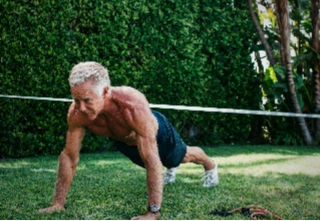 The fitness industry is in the midst of a renaissance. Flawed and dated strategies like sedentary recovery practices or overly stressful HIIT workouts are being replaced with cutting-edge practices that offer more efficiency and return on investment. Today I’m covering one emerging fitness strategy: performing brief feats of strength in the routine course of a day. Let’s call them microworkouts.
The fitness industry is in the midst of a renaissance. Flawed and dated strategies like sedentary recovery practices or overly stressful HIIT workouts are being replaced with cutting-edge practices that offer more efficiency and return on investment. Today I’m covering one emerging fitness strategy: performing brief feats of strength in the routine course of a day. Let’s call them microworkouts.
I’m talking here about dropping for a single set of deep squats in the office, hitting a set of max effort pull-ups whenever you pass under a bar in a closet doorway, or stocking your backyard with a hex deadlift bar or bench press and busting out a single set every time you pass by while taking out the garbage.
Banking Benefits With Less Stress
Microworkouts deliver two distinct and awesome benefits: First, when you add up the energy expenditure of these brief but frequent efforts, you obtain an incredible cumulative training effect. In essence, you are banking a lot of strength/power/explosiveness “mileage” without disturbing the necessary stress/rest balance of your official workout schedule or prompting the stress hormone production and cellular depletion that occurs from an extreme weekend warrior-type session. That is, a set of pull-ups, or even three sets over the course of 12 hours on a typical day, is not going to mess up the next day’s CrossFit session or even an ambitious arms and chest session. Rather, these micro sessions (Dr. Phil Maffetone calls the concept, “slow weights”) will raise the baseline from which you launch you ambitious full-scale workouts.
Think about it: If you do a single set of six deadlifts with 200 pounds on the bar every time you take out the garbage, that’s 1,200 pounds of work accomplished. Perhaps you can find your way to doing that 1-2 times a day, five or six days a week? That’s lifting an extra 10,000 pounds a week! When it’s time to perform a formal session, such as the popular 5 x 5 protocol (where you complete five sets of five reps, and perhaps add an upper body exercise to each set), you’re poised for fitness breakthroughs as well as faster recovery times. An “official” workout is no longer this tremendous athletic performance vastly outside the normal pattern of your largely sedentary life, but instead an upgrade of what you do every day to some extent. Does this concept ring a bell? Yes, microworkouts are modeling the behavior patterns of our hunter-gatherer ancestors! Grok and company likely had some harsh days that might rival today’s CrossFit WOD or obstacle course race, but they also likely had routine daily chores entailing lifting heavy things or scrambling up steep embankments in between their legendary leisure time.
Interrupting Prolonged Inactivity
The second benefit of microworkouts is perhaps even more profound: these short efforts help you combat the extreme health hazard of prolonged periods of stillness that characterize hyperconnected modern life. The adverse health consequences of stillness have been well-chronicled, and you’ve heard me talk about them for years. Studies show that even a few days of inactivity can generate a significant decline in glucose tolerance and increase in insulin resistance. In Primal Endurance, I quote Nutritious Movement queen Katy Bowman on the destruction of cellular health caused by stillness: “When you use a single position repetitively, such as curling your body into a comfortable work chair for hours every day, muscles, joints, and arteries will adapt to this repetitive positioning by changing their cellular makeup and becoming literally ‘stiff,’ with reduced ranges of motion and an actual hardening of the arterial walls in those areas.”
Strange as it may seem, it’s now becoming clear that increasing all forms of general everyday movement is a greater health priority than conducting ambitious workouts. Microworkouts, along with continued devotion to JFW (Just F—ing Walk) takes on increasing importance as daily life gets more effortless. Even if you’re a devoted gym rat, those few hours a week when you’re pushing weight around isn’t enough to combat a lifestyle of commuting, office work, and digital entertainment leisure time. The active couch potato syndrome is a scientifically validated concept revealing that devoted workout enthusiasts who lead otherwise sedentary lifestyles are subject to the same level of disease risk as inactive folks.
Optimizing Movement For the Most Advantageous Genetic Signaling
But none of this is new. A decade ago now Time magazine offered a memorable title, “The Myth Of Exercise.” The story detailed how a strenuous workout (particularly the common workout patterns and strategies of today that can become chronically stressful) depletes cellular energy and prompts a compensatory response in the form of an increased appetite along with decreased activity for the rest of the day. More recently, I wrote about the constrained model of energy expenditure as well as the amazing study of the Hadza that’s helping us reframe the purpose and intended benefits of exercise.
As I’ve been saying since the introduction of the 10 Primal Blueprint Laws over a decade ago, it’s not about the calories but about the movement and the genetic signaling that movement prompts. The Myth of Exercise concept aligns with my longtime assertion that 80% of your body composition success is dependent on your diet—specifically, minimizing the wildly excessive insulin production that happens from a grain-based, high carbohydrate diet and prevents you from burning stored body fat.
How To Incorporate Microworkouts
Armed with the insight to no workout is too short, and any kind of movement delivers a health and fitness benefit, you can elevate microworkouts to the forefront of your fitness plan. Reject the all or nothing mentality that causes you to fail with fitness commitments because you get too busy with work and life. We all have time for a set or two or three of deep squats during the workday or during leisure time.
Look for opportunities over the course of every day to put your body under some kind of brief resistance load. Even if you only work hard for one minute (or less) at a time but are relatively faithful incorporating these “micro” opportunities into your daily routine, the cumulative effect will still be incredible.
Word of Caution: Going from a prolonged inactive state to a performing a heavy lift carries an obvious risk factor. Truth be told, I generally precede my random sets of pull-ups, deadlifts or even cords by a minute of walking, a few dynamic stretches, or some specific warm-up moves like doing a set with a much lighter weight, followed by a “real” set with a respectable weight. It’s not a lot of time or effort, but it’s a good habit to add the resistance after you’ve been up and doing something for a few minutes (e.g. taking out the garbage, bringing in groceries, finishing an indoor/outdoor chore).
Beyond that, also realize that when you make micro-workouts a daily habit, you’ll discover that you’re much more adaptable to brief explosive efforts without a long warm-up. You’ll be able to pop up from your work desk to hustle down a flight of stairs at work without hearing the creaks and cracks that are so familiar, especially to aging jocks. My longtime writing partner Brad Kearns (our next book will be a comprehensive education and action plan on the topics of longevity—due out in December) swears that his brief morning flexibility/mobility routine. He says it’s transformed his recovery from sprint workouts. No more next-day stiffness and soreness and occasional minor injuries—just because he spends 12 minutes every morning working on drills specific to sprinting that challenge the glutes, hamstrings and core.
Dr. Art DeVany, Ph.D., author of The New Evolution Diet and one of my earliest and greatest inspirations for Primal-inspired health practices, says that the lion never has to stretch before a workout, and we shouldn’t have to either. No, our modern creakiness can be attributed to overtraining patterns (in the case of morning issues) or extended stillness without a movement break when you get up and hobble during the day. Our ancestors most certainly had to run for their lives with zero warning on a routine basis. It’s a good Primal skill to have still.
Micro workouts are also applicable to cardiovascular fitness. A few minutes here and a few minutes there have a similar cumulative effect. Dr. Phil Maffetone explains that any stimulation of the aerobic system, even really low intensity stuff that a hard-core athlete might not choose to count as an official workout, helps improve your cardiovascular health and fitness. There’s really no lower limit to the aerobic exercise zone.
Anytime you get up from a chair and walk, you’re getting an aerobic benefit. A couple minutes recruiting major muscle groups with Stretch Cordz confers a new advantage. A cruise ship analogy works well here. When the floating city is out on the open ocean, cruising at 20 knots en route to the next port, all twelve turbine engines are cranking at full throttle. When it’s cruising in the harbor at two knots in preparation for docking, only a couple turbines are operating at half power. However, the two turbines operating at half speed in the harbor are still being “trained” to perform when they’re called up on in the open ocean. Note: I’ve revised my position on this concept over the years as research filled in the picture. Early on, I used to designate an aerobic zone of 55-75% of maximum heart rate. I’m not saying abandon time in that range, but know that anything outside of it also counts for something, and that should be good news.
If you so much as jump up from your desk, scramble down the stairs and out to your vehicle, then return with a few floors of ascent and back to your desk—total time five minutes and eight seconds. You’ll be turbocharging fat burning, increasing oxygen delivery and blood circulation to the brain, and flooding the bloodstream with neurotransmitters that elevate mood and improve cognitive focus. Similarly, anytime you haul off a set of pushups or squats, you’re making a meaningful contribution to your fitness and longevity.
Every effort, however modest, can be a small win. How does that shift your mindset? How does it open up possibilities for you? Let me know down below, and share any questions you have while you’re at it. Have a great week, everybody.

The post Are You Doing Microworkouts? Here’s Why You Should. appeared first on Mark's Daily Apple.



August 6, 2019
Dear Mark: What Are the Differences Between Vitamin K2 MK-4 and MK-7?
 For today’s edition of Dear Mark, I’m answering a question about the different forms of vitamin K2. Everyone knows the importance of vitamin K2—at least around these parts—but very few understand the differences between the various forms of vitamin K2. What are the respective benefits of vitamin K1, vitamin K2 MK-4, and vitamin MK-7? Where can we find each one?
For today’s edition of Dear Mark, I’m answering a question about the different forms of vitamin K2. Everyone knows the importance of vitamin K2—at least around these parts—but very few understand the differences between the various forms of vitamin K2. What are the respective benefits of vitamin K1, vitamin K2 MK-4, and vitamin MK-7? Where can we find each one?
Let’s find out:
Hi Mark,
Have you ever done an in-depth look at the differences between vitamin K2 MK-4 and MK-7?
No. I’ll do one now.
For those who don’t know, vitamin K2 comes in many different forms called menaquinones. MK-4 and MK-7 are the most important menaquinones. Pretty much all the vitamin K2 you’ll encounter in foods and in supplements is either MK-7 or MK-4 (or both), so these are the ones we most care about. There are also ones like MK-11 and MK-10, but we don’t know as much about them. What we do know seems to suggest they act a lot like MK-7. Whatever the case, they’re good.
What Are the General Benefits of Vitamin K2?
It directs calcium where to go in the body, sending it to the right places and preventing it from going to the wrong places. You want calcium in your bones and teeth. You don’t want calcium clogging up your arteries or forming kidney stones in your kidneys. Vitamin K2 is the messenger regulating both good and bad calcification.
It improves energy utilization, partially by increasing insulin sensitivity. The more insulin-sensitive you are, the better you can burn glucose without requiring tons of insulin. This allows you to both handle glucose and keep burning body fat.
It’s an important regulator of sex hormone status. Much like it puts calcium in the right places and removes it from the wrong places, vitamin K2 increases testosterone in men and reduces excess testosterone in women.
It protects tissues against cancer, selectively inducing cell death in cancer cells but not in healthy ones.
It’s a powerful inductor of gene expression. In general terms, it turns good genes on and bad genes off.
What About the Benefits Of Vitamin K1?
Found in many unfermented green plant foods, vitamin K1 isn’t useless by any means. It generally heads straight to the liver, where it contributes toward regulation of blood coagulation—the thinning or thickening of blood. People with problems controlling blood coagulation often end up on warfarin, a drug that promotes blood thinning and prevents blood clots. We can convert vitamin K1 to vitamin K2, but this depends on a number of factors, like gut health (much of the conversion occurs in the gut) and usage of certain medicines (statins inhibit conversion).
Back to vitamin K2. Vitamin K2 does what vitamin K1 can do, but more effectively, and then some.
The most-studied is MK-7. The majority of the MK-7 you consume goes to the bones and liver. In the bones, the MK-7 produces osteocalcin—a hormone which regulates bone health, increases testosterone, improves cognitive function and exercise performance, and maintains healthy insulin and glucose levels. Few people know the power of the bones (they’re actually organs) and MK-7 is one of the most important co-factors for realizing that power.
The best sources of MK-7 are fermented plant foods, like natto (fermented soybeans, but natto made with black beans and presumably other legumes will also be high in MK-7).
MK-4 tends to accumulate and act in the peripheral tissues, helping prevent against unwanted and/or unhealthy calcium accumulation. It’s also integral to gene expression and activation.
The best sources of MK-4 are animal foods, like egg yolks, chicken legs and thighs (and chicken dark meat in general—I bet the oysters on a chicken carcass are incredibly high in K2), and goose liver. Pork is also quite high in MK-10 and MK-11, whose biological activities haven’t been elucidated but are likely to be very helpful.
Another good source of a mix of menaquinones is hard cheese, with emmental, jarlsberg, and edam being highest.
Almost everyone should take a vitamin K2 supplement containing both MK-4 and MK-7. Many of the most troublesome and dangerous foods and drugs wreak havoc by inhibiting vitamin K2-dependent processes.
A group of researchers made a strong case that statins, warfarin, canola oil, and hydrogenated soybean oil trigger a host of metabolic and lifestyle diseases by inhibiting vitamin K2-dependent processes in the body:
Statins reduce levels of a necessary co-factor for converting vitamin K1 into vitamin K2 in the brain, testicles, kidney, bone, and other tissues. So if you’re taking statins and want vitamin K2 improving bone health, sexual function, cognition, and lowering the risk of kidney stones, you need to take extra. You most likely need extra (throw in some CoQ10 while you’re at it, as statins also inhibit its production).
Warfarin—the blood thinning medication—reduces vitamin K recycling in the body, lowering vitamin K2 levels and even inducing arterial calcification. In effect, taking warfarin replaces the body’s need to naturally regulate blood coagulation through vitamin K, and natural processes drop off.
Canola oil and hydrogenated soybean oil both contain compounds that appear to inhibit vitamin K2 production in the body.
If you take statins, warfarin or eat canola oil and hydrogenated soybean oil, you should probably ask your doctor about supplementing with vitamin K2.
Similarly, postmenopausal women should take vitamin K2. In a recent study of postmenopausal women, those with osteoporosis had much lower levels of vitamin K2 (MK-7) than those without.
But to be honest? Supplementation is probably a good idea for everyone.
Thanks for reading, everyone. Take care and if you have any other questions about vitamin K2, drop them down below!

References:
Klapkova E, Cepova J, Dunovska K, Prusa R. Determination of vitamins K, MK-4, and MK-7 in human serum of postmenopausal women by HPLC with fluorescence detection. J Clin Lab Anal. 2018;32(5):e22381.
The post Dear Mark: What Are the Differences Between Vitamin K2 MK-4 and MK-7? appeared first on Mark's Daily Apple.



August 5, 2019
Primal + Keto Cooking Made Easy: Bacon and Balsamic Brussels Sprouts
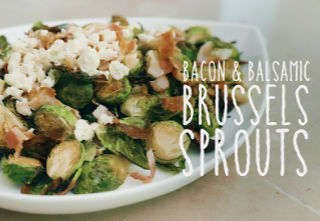 When it comes to side dishes, simple is best. A list of ingredients you can count on one hand is the way I like to do it. This dish delivers on ease and offers plenty of solid nutrition and great Primal taste. Cooking up great flavor starts with quality ingredients, for sure, but don’t underestimate the power of a great sauce or seasoning—and the right cooking method. Roasting vegetables is one of the surest ways to bring out a richer, deeper taste. Brussels sprouts work great for this. Add some balsamic and bacon, and you’ve got an amazing side for any meaty main course.
When it comes to side dishes, simple is best. A list of ingredients you can count on one hand is the way I like to do it. This dish delivers on ease and offers plenty of solid nutrition and great Primal taste. Cooking up great flavor starts with quality ingredients, for sure, but don’t underestimate the power of a great sauce or seasoning—and the right cooking method. Roasting vegetables is one of the surest ways to bring out a richer, deeper taste. Brussels sprouts work great for this. Add some balsamic and bacon, and you’ve got an amazing side for any meaty main course.
Bacon & Balsamic Brussels Sprouts
Servings: 2
Prep Time: 5 minutes
Cook Time: 20-25 minutes
Ingredients:
14 Brussels sprouts
1/4 cup Primal Kitchen® Avocado Oil
Salt & pepper to taste
3 strips cooked bacon
1/3 cup Primal Kitchen Balsamic Dressing
Optional: 1/3 cup blue cheese crumbles
Instructions:
Preheat oven to 425 ºF.
Cut the ends off of the Brussels sprouts and then slice in halves or quarters (if pieces are very large).
Place them in a bowl and drizzle with avocado oil and balsamic dressing. Sprinkle with salt and pepper. Toss to combine.
Roast for 20-25 minutes. Remove the Brussels sprouts from the oven. Then toss with cooked bacon pieces. Add blue cheese crumbles if desired.
Nutritional Information (per serving without cheese):
Calories: 488
Total Carbs: 9.2 grams
Net Carbs: 7.5 grams
Fat: 49 grams
Protein: 5.2 grams

The post Primal + Keto Cooking Made Easy: Bacon and Balsamic Brussels Sprouts appeared first on Mark's Daily Apple.



August 4, 2019
Keto Strawberry Cream Pie
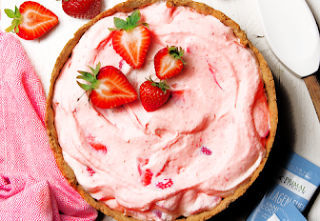 Dessert can be a final course—or it can be a true finale. This show-stopping pie definitely fits the latter category. Imagine setting this on the table in front of family and guests. Who do you think would be able to resist the colorful, creamy treat? We thought so.
Dessert can be a final course—or it can be a true finale. This show-stopping pie definitely fits the latter category. Imagine setting this on the table in front of family and guests. Who do you think would be able to resist the colorful, creamy treat? We thought so.
A little fluffier than cheesecake, the lighter filling is a great complement to a dense but sweet crust that will leave graham crackers in the dust. But the best thing? It’s low-carb, Primal and even keto-friendly.
Servings: 10 medium slices
Time In the Kitchen: 25 minutes
Cook Time: 15 minutes
Chill Time: 4 hours
Ingredients:
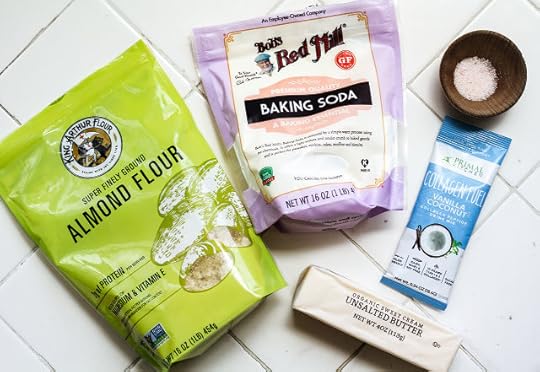
Crust:
2 1/2 cups almond flour
1 tsp baking soda
1/4 tsp kosher salt
2 Tbsp. butter, melted
1 packet (or scoop) Primal Kitchen® Vanilla Collagen Fuel
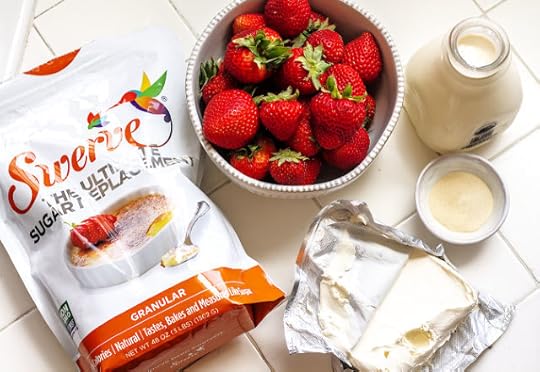
Filling:
8 oz. organic cream cheese, softened
4 cups fresh strawberries, divided
2 cups organic heavy cream
2 Tbsp. Swerve (or more to taste)
2 tsp. vanilla
1 Tbsp. gelatin
5 Tbsp. boiling water
Instructions:

For crust, blend almond flour, Collagen Fuel, baking soda and salt in a bowl. Add butter and mix well.
Scrape the batter into a 9-inch springform pan. Smooth the crust mixture over the bottom and up the sides with your fingers or a rubber spatula.
*Note: if crust doesn’t come together, add a little more melted butter.

Place the pie on a cookie sheet (to keep the bottom from burning), and bake for 15 minutes at 350 ºF.
For pie filling, add boiling water to gelatin and whisk (by hand/hand mixer or in a standing mixer) until completely dissolved. Add cream cheese to gelatin and whip for about two minutes. (If using a standing mixer, scrape out cream cheese mixture into a side bowl.)
Whip the heavy cream until soft peaks form. Then add vanilla and whip until stiff peaks form. Add the cream cheese mixture to the whipping cream and whip until just combined.
Mash half of the berries, and chop the other half.
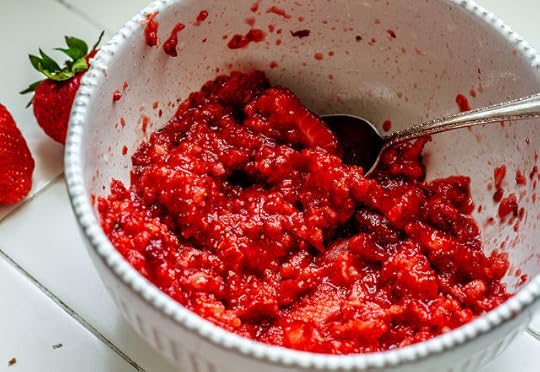
Add the mashed berries to the whipped cream/cream cheese mixture. Using an immersion blender or mixer, blend until creamy with no lumps remaining. Add Swerve to taste.
Pour into crust and chill for four hours.
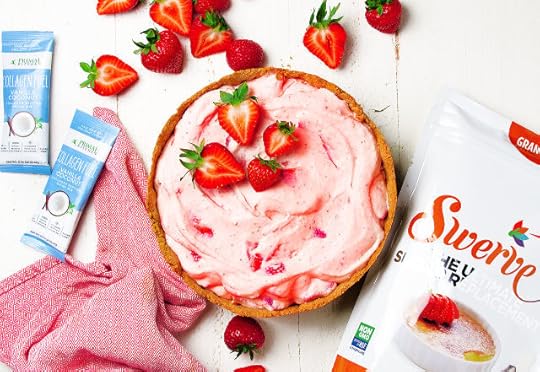
Nutritional Information (per medium slice, 1/10th of pie):
Calories: 453
Net Carbs: 8.7 grams
Total Carbs: 13 grams
Fat: 42 grams
Protein: 10 grams

The post Keto Strawberry Cream Pie appeared first on Mark's Daily Apple.



August 2, 2019
Weekly Link Love — Edition 40
 Research of the Week
Research of the Week12 weeks on a ketogenic diet normalized metabolic and psychological health markers in a 65-year-old woman who’d had type 2 diabetes and clinical depression for 26 years.
Rewiring the brain with gratitude.
Higher protein intakes may save senior bone health.
Oh, good! They’re making “advances” in tech for reducing the cholesterol content of egg yolks.
New Primal Blueprint Podcasts

Episode 361: Josh Perry: Host Elle Russ chats with Josh Perry, a former pro BMX athlete, current motivational speaker, and certified health coach who’s using a ketogenic diet to fight four brain tumors.

Primal Health Coach Radio, Episode 20: Hosts Erin and Laura chat with Kate Jaramillo about the necessity of creating it if it doesn’t exist.
Each week, select Mark’s Daily Apple blog posts are prepared as Primal Blueprint Podcasts. Need to catch up on reading, but don’t have the time? Prefer to listen to articles while on the go? Check out the new blog post podcasts below, and subscribe to the Primal Blueprint Podcast here so you never miss an episode.
Media, Schmedia
Government panel of nation with thousands of years of history eating cheese, butter, and meat rule that cheese, butter, and meat are terribly unhealthy. And some people have commented on the report.
Here’s what happens to your organs in extreme heat.
I still chuckle at the notion that not eating between meals is a “fad.”
Interesting Blog Posts
Yeah, what if?
Social Notes
I had a great time with Shawn Baker, Paul Saladino, and Brian Sanders discussing meat on Brian’s Peak Human podcast.
Don’t forget about the humble, mighty pushup.
Everything Else
Not all restaurants are buying into the Beyond Meat hype.
What fish can teach us about regenerating limbs.
Man bedridden for 11 years invents a surgery to cure himself.
The curative potential of mastic, ancient Greek medicinal shrub.
Here’s what you’ll be allowed to buy at the grocery store in our glorious future.
Things I’m Up to and Interested In
What I mean by “Live Long, Drop Dead”: This.
I think we all knew this: Trees are better than grass.
Story I enjoyed reading: “The Death of a Chimpanzee.”
I marvel at human ingenuity: The innovative new process converting vegetables into meat.
This is wild: One of the longest-lived “organisms” is a 6000 year-old sexually-transmitted dog cancer.
Question I’m Asking
How do you intend to “live long, drop dead”? What will you be doing, and does it involve an escalator?
Recipe Corner
I’m not a big cocktail guy, and I rarely post alcohol recipes, but PaleOMG always has good stuff, and this carrot margarita looks very impressive.
Using pickle juice to brine chicken wings is genius.
Time Capsule
One year ago (Jul 28– Aug 3)
What Are Exogenous Ketones and Who Should Take Them? – Do you need a boost?
Metabolism and Menopause: What Does Research Suggest is the Best Dietary Strategy?– Can diet make menopause better?
Comment of the Week
“My nemesis is the lone star tick, here in rural TN. I created a repellent that I actually tested on a tick. First the recipe: rose geranium oil plus citronella oil, diluted in jojoba oil and a bit of alcohol. I put this in a sprayer. The alcohol makes it easier to spray and less thick.
I tested it by spraying it on a table, and putting a tick next to it. The tick tried to get away from the sprayed spot as fast as possible, repeatedly. Every day, I put this stuff NEAR but not ON the places you never want to get a tick, when I get dressed in the morning. (Mucus membranes should not be exposed to essential oils.)
Also I spray my hat and shoes with permethrin and let it dry overnight. This lasts a few months as a repellent and is relatively non-toxic.
Inspect yourself every evening for ticks. If one bites you, but you get it off within 24 hours, it is unlikely to infect you with any diseases.”
– Good tick tips, shannon stoney.

The post Weekly Link Love — Edition 40 appeared first on Mark's Daily Apple.



Mark Sisson's Blog
- Mark Sisson's profile
- 199 followers



